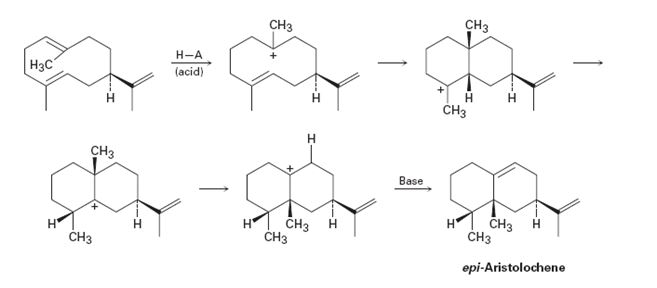
Concept explainers
Interpretation:
The mechanism for each step in the pathway given for bio synthesizing epi-Aristolochene is to be shown using curved arrows. Further the steps that involve electrophilic addition(s) to the

Concept introduction:
While drawing curved arrows the head of the curved arrow starts from the nucleophilic source (either negatively charged or neutral) and ends in an electrophilic sink (either positively charged or neutral). The formation of a new bond should lead to the breaking of a bond that already exists as the octet rule cannot be violated.
In electrophilic addition reactions, the first step is the attack of the π electrons of the double bond on the hydrogen of another reactant to yield a carbocation. One of the carbon in C=C gets attached to hydrogen while the other acquires a positive charge. In the second step, the carbocation formed can rearrange to give another more stable carbocation either by a hydride shift (shift of hydrogen atom with its electron pair) or by an alkyl shift (shift of an alkyl group with its electron pair) between neighboring carbons. In the last step the carbocation produced reacts with a negatively charged ion or eliminates a proton to give the product.
To show:
The mechanism for each step in the pathway given for bio synthesizing epi-aristolochene using curved arrows. Further to identify the steps that involve electrophilicaddition(s) to the alkene and that involve carbocation rearrangement(s).
Trending nowThis is a popular solution!

Chapter 7 Solutions
Organic Chemistry
- Match the denticity to the ligand. Water monodentate ✓ C₂O2 bidentate H₂NCH₂NHCH2NH2 bidentate x EDTA hexadentate Question 12 Partially correct Mark 2 out of 2 Flag question Provide the required information for the coordination compound shown below: Na NC-Ag-CN] Number of ligands: 20 Coordination number: 2✔ Geometry: linear Oxidation state of transition metal ion: +3 x in 12 correct out of 2 question Provide the required information for the coordination compound shown below. Na NC-Ag-CN] Number of ligands: 20 Coordination number: 2 Geometry: linear 0 Oxidation state of transition metal ion: +3Xarrow_forwardCan you explain step by step behind what the synthetic strategy would be?arrow_forwardPlease explain step by step in detail the reasoning behind this problem/approach/and answer. thank you!arrow_forward
- 2. Predict the product(s) that forms and explain why it forms. Assume that any necessary catalytic acid is present. .OH HO H₂N OHarrow_forwardconsider the rate of the reaction below to be r. Whats the rate after each reaction? Br + NaCN CN + NaBr a. Double the concentration of alkyl bromide b. Halve the concentration of the electrophile & triple concentration of cyanide c. Halve the concentration of alkyl chloridearrow_forwardPredict the organic reactant that is involved in the reaction below, and draw the skeletal ("line") structures of the missing organic reactant. Please include all steps & drawings & explanations.arrow_forward
- What are the missing reagents for the spots labeled 1 and 3? Please give a detailed explanation and include the drawings and show how the synthesis proceeds with the reagents.arrow_forwardWhat is the organic molecule X of the following acetal hydrolysis? Please draw a skeletal line structure and include a detailed explanation and drawing of how the mechanism proceeds. Please include any relevant information that is needed to understand the process of acetal hydrolysis.arrow_forwardWhat are is the organic molecule X and product Y of the following acetal hydrolysis? Please draw a skeletal line structure and include a detailed explanation and drawing of how the mechanism proceeds. Please include any relevant information that is needed to understand the process of acetal hydrolysis.arrow_forward
- At 300 K, in the decomposition reaction of a reactant R into products, several measurements of the concentration of R over time have been made (see table). Without using graphs, calculate the order of the reaction. t/s [R]/(mol L-1) 0 0,5 171 0,16 720 0,05 1400 0,027arrow_forwardPredict the organic products that form in the reaction below, and draw the skeletal ("line") structures of the missing organic products. Please include all steps & drawings & explanations.arrow_forwardWhat are the missing reagents for the spots labeled 1 and 3? Please give a detailed explanation and include the drawings and show how the synthesis proceeds with the reagents.arrow_forward
 EBK A SMALL SCALE APPROACH TO ORGANIC LChemistryISBN:9781305446021Author:LampmanPublisher:CENGAGE LEARNING - CONSIGNMENT
EBK A SMALL SCALE APPROACH TO ORGANIC LChemistryISBN:9781305446021Author:LampmanPublisher:CENGAGE LEARNING - CONSIGNMENT

